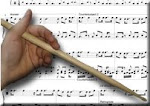 Right, well it's been quite some time since I posted on the blog and it's likely much readership has fallen off. So be it. I still intend to continue this in spite of my own lack of consistency. Today's post is another whiteboard drawing done for my classroom. I'm teaching a unit on Medieval and Gothic art which contains an extensive look at illuminated manuscripts. I've devised a project in which my students will each produce their own illuminated manuscript based on their choice of a lyric, poem, or excerpt of literature. Each student will produce a recto (right hand page) consisting of the text, an ornamental capital, and a decorative border, as well as a verso (left hand page) containing a suitable illumination for the text and it's own decorative border.
Right, well it's been quite some time since I posted on the blog and it's likely much readership has fallen off. So be it. I still intend to continue this in spite of my own lack of consistency. Today's post is another whiteboard drawing done for my classroom. I'm teaching a unit on Medieval and Gothic art which contains an extensive look at illuminated manuscripts. I've devised a project in which my students will each produce their own illuminated manuscript based on their choice of a lyric, poem, or excerpt of literature. Each student will produce a recto (right hand page) consisting of the text, an ornamental capital, and a decorative border, as well as a verso (left hand page) containing a suitable illumination for the text and it's own decorative border. In addition to illuminated manuscripts, which were typically hand painted, I've been discussing woodcut prints, a popular form in Medieval art. I'm asking the students to combine the techniques for this project. In the case of the recto, I'm requiring each to create a linocut (easier than wood) for the ornamental capital that usually begins the text. We'll print the block on parchment (modern), then add the text and ornamentation using markers. Once the recto is complete, we'll produce a verso consisting of a larger linocut image depicting, i.e. illuminating, some aspect of the text. We'll then add a decorative border to accentuate the illumination. All in all it should give the students an interesting introduction to medieval art (with a modern twist) using two of the popular styles of the day.
The whiteboard drawing that I've created uses dry erase markers to demonstrate the concept. The ornamental capital was created by filling in a rectangle with black ink, then using a paper towel to "cut out" the letter and leave patterned marks around it. This is meant to simulate the woodcut process, a subtractive method of drawing. The decorative border in this case is intended to introduce the students to the practice of creating weaving and branching patterns, something I had them practice several times as bell work. The text I've chosen is a "madrigal" by P.D.Q. Bach (Peter Schickle) called "My Bonny Lass She Smelleth". I thought it an appropriate choice because it actually parodies medieval music.


No comments:
Post a Comment